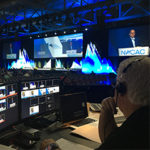Five years ago, we asked leading architects from around the world to describe how they envisioned the convention center of the future. The future they helped us imagine is here — and our guides proved to be remarkably prescient.
The major trends the architects identified, such as the connection of convention centers with their destinations and the demand for flexible spaces where people can meet in new ways, are evident, not just in the buildings they themselves designed but throughout the meetings world. And although they didn’t call it this at the time, their insights revealed their rootedness in design thinking, which puts the experience of the human beings who use a building first.
GOODBYE, BIG BOX
The conviction that convention centers would become less isolated and more connected to the cities and spaces around them — noted by virtually all the architects in our 2010 story — is one that not only has continued to grow, but has become all the more emphatic. That represents a big change from the days when conference organizers fretted over the possibility that a vibrant environment outside the center might tempt meeting attendees to “God forbid, leave the building” and never come back, said Michael Lockwood, principal and a project designer for the global convention center practice at Populous, which is headquartered in Kansas City, Missouri. Today, having interesting surroundings is regarded as a plus. “Attendees can leave, grab some fresh air or visit a food truck,” Lockwood said, “and come back in a positive frame of mind.”
Bookings will be higher for convention centers that can offer an authentic experience of their cities.
Bookings will be higher for convention centers that can offer an authentic experience of their cities, Lawrence Speck, a senior principal at Page architecture and engineering firm, the lead architect for the Austin Convention Center, and the author of award-winning design guidelines for a 40-block area around the center, told Convene via email. “Attendees will want to easily go between local eateries, entertainment venues, assorted hotels, and walkable urban fabric. They will not want to be cooped up in a single building for hours on end,” Speck said. “And even when they are in the building, they will want to get lots of vistas out, so they feel like they are a part of the larger urban community they are visiting.”
FILLING IN THE BLANKS
New York City’s Jacob K. Javits Convention Center was built in the early 1980s in an industrial area on the west side of Manhattan, right on the Hudson River — a place where there was little commercial development. The site was chosen, according to Javits President and CEO Alan Steel, in the hope that the center, which bills itself as the busiest in the United States, would stimulate economic activity in the area.

There are things about cities that make them attractive, that have been true forever, and will always be true
And decades later, the city is finally filling in the blanks. The once-marooned center is part of the 28-acre Hudson Yards redevelopment project, which includes a mix of residential, office, retail, and public space. A recent renovation at Javits has opened the center up, offering panoramic views of the Hudson, and topped the building with a nearly seven-square-acre green roof. And the High Line, an art-filled public park built along a one-and-a-half-mile historic elevated freight railway — one of the city’s most visited attractions — begins right outside the door.
Similarly, in Boston, the Massachusetts Convention Center Authority (MCCA) has turned 2.7 acres of green space outside the Boston Convention & Exhibition Center (BCEC) into an experimental event space, The Lawn at D, to test ways to integrate the building and its visitors with locals. “There are things about cities that make them attractive, that have been true forever, and will always be true,” said Robert Svedberg, director of the convention center design practice at Atlanta-based tvdesign.“Not forgetting those, the basics of it, is really the most important thing. Activating the streets, getting the scale right, … these aren’t mysteries to anyone, but it’s amazing how often they are ignored.”
THE ‘DISTRIBUTED’ CONFERENCE
In 2010, Mark Reddington, an architect and design partner with Seattle-based LMN Architects, which designed the Vancouver Convention Centre’s green-roof-topped West Building, suggested in Convene that “as the integration of the facility with the urban fabric continues to deepen, we may also see the convention center become more fragmented, broken into discrete pieces and distributed into the fabric of the city.” And sure enough, versions of distributed meetings are occurring, as destinations partner with companies and organizations within a city to connect attendees with local innovators, business and academic resources, and experts.
“The convention center might be the node of an event,” Svedberg said, “but it reaches out and engages the entire community. You can have sessions that might have one focus over in a university and sessions that have another focus that might be in an industrial space somewhere else. The idea is that when you’re bringing a group of people and a group of exhibitors and a group of experts to a city, you can leverage that with homegrown talent.
“I don’t have data that’s going to prove this, but I think the potential is that maybe everyone can make more money by collaborating more,” Svedberg said. “You might not capture every dollar that can be spent, but maybe more people will come to the event, or advertisers will be able to spend more money because they’re getting a broader audience.
DEEPENING RELATIONSHIPS
“Community engagement used to mean, ‘We let the Cub Scouts meet in our building,’” Svedberg noted. But in recent years, the architect has observed a growing web of stronger, more meaningful ties between convention centers and local communities.
Today, convention-center staffs build Habitat for Humanity houses, plant community gardens, compost and recycle, and give out the compost to the community. “There’s a real engagement of the people who work and run the buildings with the people in the community,” Svedberg said. “It’s a new thing — it didn’t used to be that way. These buildings are really engaged in their community when they’re successful.”
ARCHITECTURE FOLLOWS EXPERIENCE
When Lockwood begins work with new clients at the beginning stages of building or renovating a convention center, he warns them that they might be surprised when he doesn’t jump right into discussions about proportion and materials. “I tell my clients that, look, I’m a licensed architect and the lead designer of our convention center practice, but sometimes the last thing I’m going to talk to you about is architecture,” he said. “We have to get so many other things right. We have to prioritize the human experience first and we have to understand what we’re looking for in the experience.
“I always like to say, ‘The architecture will come when it’s ready,’” Lockwood said. “We absolutely will deliver on the architectural components of the project — when the experience has been designed.”
A recent renovation of the San Jose Convention Center in Northern California, which Populous oversaw, offers a prime example of what Lockwood is talking about. “The building formed itself out of the experience we were trying to create,” he said. Populous prioritized outdoor event spaces, balconies, views of the city, natural light, and reclaimed local redwood to evoke “all of the feelings” of sunshine-filled San Jose, Lockwood said. “The building becomes a vessel for communicating those ideas.”
THE STORYTELLING CENTER
Architecture can also tell stories about a destination’s culture, Svedberg said. “We used to hear clients talk about iconic buildings,” the architect has written. “When we see RFPs now, we see the word ‘unique’ a lot more than ‘iconic.’ I think that’s a really important shift. Sometimes you need the dramatic, iconic building as a sales tool, but what you need to stay top of mind is a really rich experience that is specific to each destination.”
The design for Music City Center in Nashville, the country music capital of the world, for example, has flowing lines that are similar to a guitar body and the area’s rolling hills, while the carpet pattern riffs on sound waves. In Detroit, the façade of the Cobo Center — another of Svedberg’s projects — evokes a sense of motion, in keeping with Motor City’s automotive history. Both designs suggest the motifs rather than hit visitors over the head with them. Using architecture to materially represent a space “can be hokey,” Svedberg said, “and it’s hard to pull off if it’s too hokey. But if it’s done in a really sophisticated way, it will have a long-term life, I think.”
THINKING OUTSIDE THE BALLROOM
“People are spending less and less time in the formal sessions, and more and more time hanging out,” Svedberg said. “That’s something you hear when you talk to building operators — that’s a relatively new trend.”
Long Beach, California, was an early adopter of the practice of making it easy for those informal hangout meetings to take place by providing sofas, chairs, and other flexible seating arrangements in the lobbies, hallways, and other public spaces at the Long Beach Convention & Entertainment Center. “Early on, we had one planner that asked us to strip out all the public seating, as they were afraid that it would prevent attendees from visiting [other meeting areas],” said Steve Goodling, president and CEO of the Long Beach Convention & Visitors Bureau. Goodling’s team honored the request. The next morning, however, the planner was back, “asking us how quickly we could put the furniture back in,” Goodling said. “They were getting multiple complaints from their attendees.”
People aren’t willing to dedicate two or three days of their lives anymore to being disconnected from their world.
In addition to space that facilitates and fosters networking, clients also are looking for unique spaces that are “indigenous” to an area as an alternative to traditional meeting spaces, said Goodling, whose team is now planning event space under a bridge, complete with turnkey LED lighting and chandeliers. “It creates yet another venue,” Goodling said, “for great street parties with food trucks.”
SPACE THAT HELPS YOU LEARN
Five years ago in Convene, Svedberg predicted that “impersonal and generic spaces [in convention centers] would be replaced by multiple casual and intimate spaces with distinctive personalities and experiences.” That trend is continuing, and reflects the increasingly interactive, collaborative nature of work and learning that traditional “pipe and drape” meeting spaces can inhibit, he said recently. “You really kind of get trained by your environment,” Svedberg said. “If you’re sitting in your place with the row of chairs at a lecture, you’re there to listen. When you put a desk in front of me, maybe you’re there to listen and you’re going to take notes. When you put chairs in a circle, you’re going to have a conversation.”
There’s a need, Svedberg said, for spaces that could be used for hands-on collaboration — a more intimate, workshop kind of space, where attendees could do hands-on experimentation. Those spaces can be flexible enough so that one day they function as a kind of a lab, another day it can be a lounge, on another day a seating area, or a food-service area, Svedberg said. “It’s something that is more informal and more private.”
REDEFINING ‘CONNECTED’
Convention centers typically have concentrated on connecting attendees with one another in shared space, but designers are now responding to the need that attendees have to be connected to their lives outside of meetings. “Technology used to mean, ‘I want to be able to connect digitally with people or be able to be connected while I’m on the road,’” Lockwood said. “Whereas now, … it means, ‘I want to make sure my technology allows me to duck out of a meeting room and have a Skype conversation with my kids. I want to be connected to my life. I want to be connected to my world, whether it be my spouse, my kids, my significant other, my colleagues back at work. I need to be able to have a real-time, live conversation, through technology, with my wife, away from this conference.’”
People aren’t willing to dedicate two or three days of their lives anymore to being disconnected from their world, he added. “That’s way in the past,” Lockwood said.
“Convention centers need to provide not only the technology, but also make the spaces available.”
SUSTAINABILITY — FOR ATTENDEES
The idea of building spaces in ways that are as self-sustaining as possible is so deeply embedded in convention-center design, it’s not a trend, it’s just a fact of life, Svedberg said. What is new, however, is the focus on attendee wellbeing: natural light, comfortable places to sit, access to fresh air, exercise, green space, and healthy food. “People want to know that what they’re eating came from a local vendor,” Svedberg said. “That’s absolutely huge, the food and the quality of the spaces. The spaces have to have a certain level of quality. Those kind of industrial, institutional-feeling spaces are just not going to play.”
Workspaces have become more comfortable and inspiring, Lockwood points out. So why would somebody travel to a conference only to spend three days in a windowless room? The basic desire for comfortable spaces to meet as human beings, he said, is universal. Indeed, people want to be together for great experiences. “There is power,” Lockwood said, “in realizing it’s not about architecture, it’s about creating a space where people can gather. Then everything else starts to take care of itself.”






